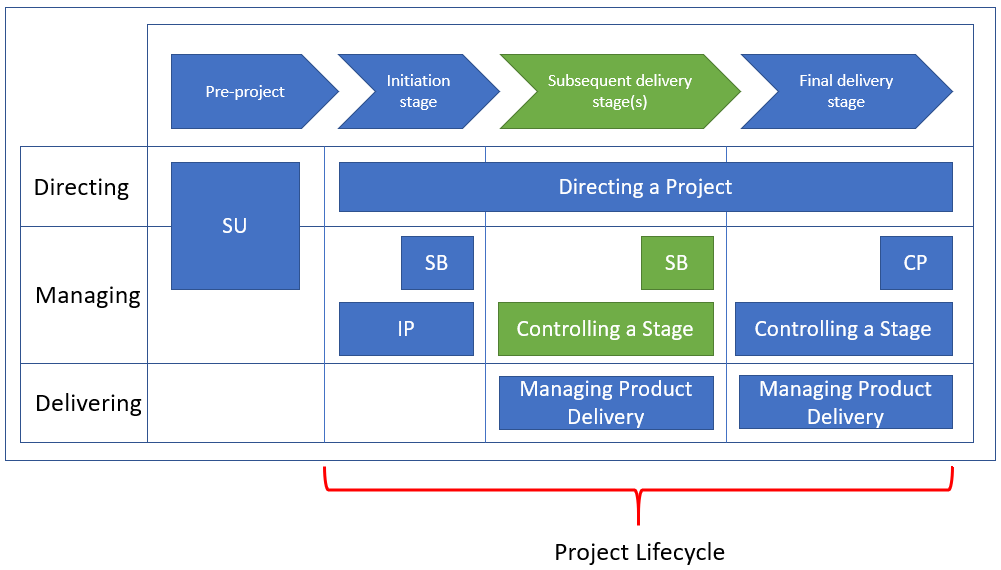Lexicon / PRINCE2
Previous / next: Project Management Institute PMBOK Guide / Project Planning Breakthroughs
Using the PRINCE2 Methodology
The following is the Doldrum Bay Consulting high-level summary of the structured project management method, PRINCE2®, as proposed by AXELOS *.
History of PRINCE2®
PRINCE2® was originally developed as a UK government standard for information systems projects but has now been adopted worldwide for projects outside of the IT world.
Methodology
According to the Doldrum Bay Consulting Lexicon of Project Management terms, PRINCE2® can be defined as a methodology.
What is a project according to PRINCE2®?
The PRINCE2® definition of a project is very similar to the one defined by the PMI. In their book, "Managing Successful Projects with PRINCE2®" 2017 Edition, PRINCE2® defines a project as "a temporary organisation that is created for the purpose of delivering one or more business products." [1]
What is Project Management according to PRINCE2®?
The PRINCE2 definition of project management is also very similar to the one defined by the PMI. In their book, "Managing Successful Projects with PRINCE2®" 2017 Edition, PRINCE2® defines project management as the "planning, delegating, monitoring and control of all aspects of the project, and the motivation of those involved, to achieve the project objectives within the expected performance targets for time, cost, quality, scope, benefits and risk. [1]
Like the PMI, the PRINCE2® definition also mentions six aspects (also called tolerances or performance goals) which quantify the project tolerance. These can also be called the project KPIs (Key Performance Indicators):
- Costs
- Timescales
- Quality
- Scope
- Benefits
- Risk
Key components in Project Management according to PRINCE2®
In PRINCE2® terms, most projects follow these stages:
- Initiating the project – defining what the project will achieve and realise, working alongside the project sponsor and stakeholders to agree a set of deliverables.
- Planning – recording all the tasks and assigning deadlines for each of them, including defining the relationships and dependencies between each activity.
- Execution – building the project team and collecting and allocating the resources and budget available to specific tasks.
- Monitoring – overseeing the progress of the project work and updating the project plans to reflect actual performance.
- Closing – ensuring that the outputs delivered by the project are accepted by the business and then closing down the project team.
Therefore, PRINCE2® defines seven processes that contain several activities that need to be performed.
- Starting Up A Project (SU), in which the project team is appointed including an executive and a project manager, and a project brief is produced
- Initiating A Project (IP), in which the business case refined, and Project Initiation Documentation assembled
- Directing A Project (DP), which dictates the ways in which the Project Board oversees the project
- Controlling A Stage (CS), which dictates how each individual stage should be controlled, including the way in which work packages are authorised and distributed
- Managing Product Delivery (MP), which has the purpose of controlling the link between the Project Manager and the Team Manager(s) by placing formal requirements on accepting, executing and delivering project work.
- Managing Stage Boundaries (SB), which dictates how to transition from one stage to the next
- Closing A Project (CP), which covers the formal decommissioning of the project, follow-on actions and evaluation of the benefits.
As with the PMI methodology, the PRINCE2® processes are not the phases of the project. The processes may need to be performed several times before a phase is complete. See diagram below (the two letter boxes refer to the PRINCE2® process acronym above).

Example deliverables according to PRINCE2®
PRINCE2 uses the term Management Products instead of deliverables. The Management Products are grouped into three categories; baseline products, records and reports.
PRINCE2® baseline products
These are management products that define aspects of the project that, once approved, are subject to change control.
Examples include:
- Business case
- Plan (project, stage and team)
- Project brief
- Project initiation documentation (PID)
PRINCE2® records
These are dynamic management products that maintain information regarding project progress.
Examples include:
- Issue register
- Lessons log
- Risk register
PRINCE2® reports
These are management products that provide a snapshot of the status of certain aspects of the project.
Examples include:
- Checkpoint report
- Highlight report
- Issue report
- Lessons report
References
[1] "Managing Successful Projects with PRINCE2®" 2017 Edition, ISBN-13: 978-0113315338 May 2017 and https://www.axelos.com/best-practice-solutions/prince2/what-is-project-management
* "PRINCE2® is a (registered) Trade Mark of AXELOS Limited. All rights reserved."
Other Project Management approaches and methodologies
To learn about some of them, choose one of the following methodologies/approaches/good practices: